-
 bitcoin
bitcoin $106680.127705 USD
0.67% -
 ethereum
ethereum $3615.722480 USD
-0.65% -
 tether
tether $0.999925 USD
-0.04% -
 xrp
xrp $2.550072 USD
5.91% -
 bnb
bnb $1002.572269 USD
-0.90% -
 solana
solana $168.746669 USD
1.08% -
 usd-coin
usd-coin $0.999832 USD
-0.03% -
 tron
tron $0.297244 USD
1.97% -
 dogecoin
dogecoin $0.182965 USD
0.71% -
 cardano
cardano $0.600432 USD
2.56% -
 hyperliquid
hyperliquid $41.439691 USD
-1.57% -
 chainlink
chainlink $16.548399 USD
2.40% -
 bitcoin-cash
bitcoin-cash $524.993680 USD
3.45% -
 stellar
stellar $0.302259 USD
4.10% -
 zcash
zcash $539.994871 USD
-16.31%
How to combine StochRSI and trading volume? Can it enhance the signal?
Combining StochRSI with trading volume can enhance trading signals by confirming overbought/oversold conditions and trend reversals in cryptocurrency markets.
May 23, 2025 at 05:49 am

In the realm of cryptocurrency trading, combining technical indicators to enhance trading signals is a common strategy. One such combination that traders often explore is the use of the Stochastic Relative Strength Index (StochRSI) alongside trading volume. This article delves into how these two indicators can be used together and whether this combination can enhance trading signals.
Understanding StochRSI
The Stochastic Relative Strength Index (StochRSI) is a technical indicator derived from the Relative Strength Index (RSI). It is designed to identify overbought and oversold conditions in the market. The StochRSI oscillates between 0 and 1, with readings above 0.8 typically considered overbought and readings below 0.2 considered oversold.
To calculate the StochRSI, you first compute the RSI over a specified period (commonly 14 days). Then, you apply the stochastic formula to the RSI values. The formula for the StochRSI is as follows:
[ \text{StochRSI} = \frac{\text{RSI} - \text{Lowest Low RSI}}{\text{Highest High RSI} - \text{Lowest Low RSI}} ]
Where:
- Lowest Low RSI is the lowest RSI value over the lookback period.
- Highest High RSI is the highest RSI value over the lookback period.
Understanding Trading Volume
Trading volume is the total number of shares or contracts traded within a specified time frame. In the context of cryptocurrencies, it represents the total number of coins traded during a given period. Volume is a crucial indicator because it provides insights into the strength of a price move. High volume during a price increase suggests strong buying interest, while high volume during a price decrease indicates strong selling pressure.
Combining StochRSI and Trading Volume
Combining StochRSI with trading volume can provide traders with more robust signals. Here’s how these two indicators can be used together:
Identifying Overbought and Oversold Conditions
When the StochRSI indicates an overbought condition (above 0.8), traders should look at the trading volume. If the volume is high, it confirms the overbought signal, suggesting that the price may soon reverse. Conversely, if the volume is low, the overbought signal might be less reliable, indicating a potential false signal.
Similarly, when the StochRSI indicates an oversold condition (below 0.2), traders should check the trading volume. High volume during an oversold condition suggests strong buying interest and a potential price rebound. Low volume during an oversold condition might indicate a lack of buying pressure, suggesting that the price might continue to fall.
Confirming Trend Reversals
StochRSI can be used to identify potential trend reversals. When the StochRSI crosses above 0.2 from below, it signals a potential bullish reversal. When it crosses below 0.8 from above, it signals a potential bearish reversal. To confirm these signals, traders should look at the trading volume. A high volume accompanying the StochRSI signal increases the likelihood of a genuine trend reversal.
Divergence Analysis
Divergence occurs when the price of an asset moves in the opposite direction of an indicator. In the case of StochRSI, bullish divergence happens when the price makes a lower low, but the StochRSI makes a higher low. Bearish divergence occurs when the price makes a higher high, but the StochRSI makes a lower high.
To enhance the signal, traders should check the trading volume during these divergences. High volume during bullish divergence increases the likelihood of an upward price movement. High volume during bearish divergence suggests a higher chance of a downward price movement.
Practical Application of StochRSI and Trading Volume
To effectively combine StochRSI and trading volume, follow these steps:
- Set up your charting platform: Ensure that your trading platform allows you to add both StochRSI and volume indicators.
- Configure StochRSI settings: Typically, a 14-period RSI with a 3-period StochRSI works well. Adjust these settings based on your trading style.
- Monitor StochRSI levels: Watch for levels above 0.8 and below 0.2 to identify potential overbought and oversold conditions.
- Analyze trading volume: When StochRSI signals an overbought or oversold condition, check the volume to confirm the signal.
- Look for divergences: Identify divergences between price and StochRSI, and use volume to confirm these signals.
- Trade based on confirmed signals: Enter trades when both StochRSI and volume confirm a signal.
Enhancing Signals with StochRSI and Trading Volume
The combination of StochRSI and trading volume can indeed enhance trading signals by providing a more comprehensive view of market conditions. Here are some ways this combination can improve signal accuracy:
Increased Confidence in Signals
When both StochRSI and trading volume confirm a signal, traders can have greater confidence in the validity of the signal. For example, an overbought signal from StochRSI accompanied by high volume provides a stronger indication that a price reversal is imminent.
Reduced False Signals
By using trading volume to confirm StochRSI signals, traders can reduce the number of false signals. A StochRSI signal that occurs with low volume is less likely to result in a significant price move, helping traders avoid acting on weak signals.
Better Timing of Entries and Exits
The combination of StochRSI and trading volume can help traders time their entries and exits more effectively. For instance, waiting for high volume to confirm a StochRSI signal can help traders enter trades at more favorable prices and exit before significant reversals occur.
Frequently Asked Questions
Q: Can StochRSI and trading volume be used for all cryptocurrencies?A: Yes, StochRSI and trading volume can be applied to any cryptocurrency that has sufficient trading data. However, the effectiveness of these indicators may vary depending on the liquidity and volatility of the specific cryptocurrency.
Q: How often should I check the StochRSI and trading volume to make trading decisions?A: The frequency of checking these indicators depends on your trading strategy. For day traders, checking every few minutes to an hour may be necessary. For swing traders, checking daily or even weekly might be sufficient.
Q: Are there any other indicators that can be used in conjunction with StochRSI and trading volume?A: Yes, other indicators such as Moving Averages, MACD, and Bollinger Bands can be used alongside StochRSI and trading volume to further enhance trading signals. Each indicator provides different insights, and combining them can offer a more holistic view of market conditions.
Q: Can the StochRSI and trading volume strategy be automated?A: Yes, the strategy can be automated using trading bots or algorithmic trading platforms. However, setting up such systems requires a deep understanding of programming and the specific indicators, as well as continuous monitoring and adjustments to ensure optimal performance.
Disclaimer:info@kdj.com
The information provided is not trading advice. kdj.com does not assume any responsibility for any investments made based on the information provided in this article. Cryptocurrencies are highly volatile and it is highly recommended that you invest with caution after thorough research!
If you believe that the content used on this website infringes your copyright, please contact us immediately (info@kdj.com) and we will delete it promptly.
- SEI Price Prediction: Reversal Target in Sight? What the Charts Say
- 2025-11-12 05:10:01
- BlockDAG, Mantle, and Tron: Charting the Course for Crypto Dominance in 2025
- 2025-11-12 05:20:01
- BlockDAG, Dev Incentives, and Crypto Investment: A 2025 Perspective
- 2025-11-12 05:35:01
- Decoding XRP: From Crypto Chaos to Global Liquidity Standard?
- 2025-11-12 05:25:01
- Coinbase, BVNK, and Stablecoins: A New York Minute on Crypto's Next Big Moves
- 2025-11-12 04:35:02
- Polkadot Builder Party: Social Signals and DOT's Market Momentum
- 2025-11-12 05:40:01
Related knowledge

What's the best way to learn the TRIX indicator?
Nov 10,2025 at 12:39pm
Understanding the Basics of the TRIX Indicator1. The TRIX (Triple Exponential Average) indicator is a momentum oscillator designed to filter out short...
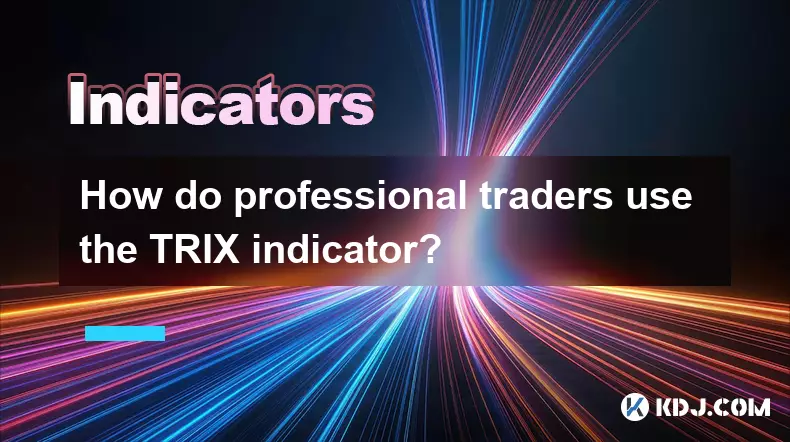
How do professional traders use the TRIX indicator?
Nov 06,2025 at 04:40pm
Understanding the TRIX Indicator in Crypto TradingThe TRIX (Triple Exponential Average) indicator is a momentum oscillator used by professional trader...
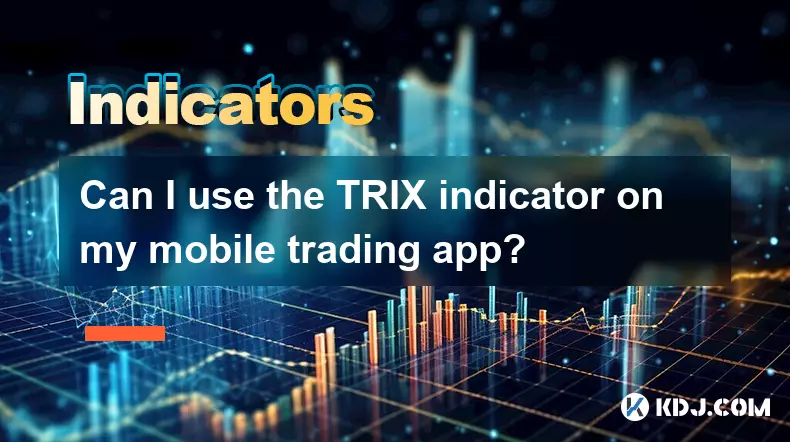
Can I use the TRIX indicator on my mobile trading app?
Nov 07,2025 at 07:40pm
The TRIX indicator, a momentum oscillator designed to filter out short-term fluctuations and highlight long-term trends, has become increasingly popul...
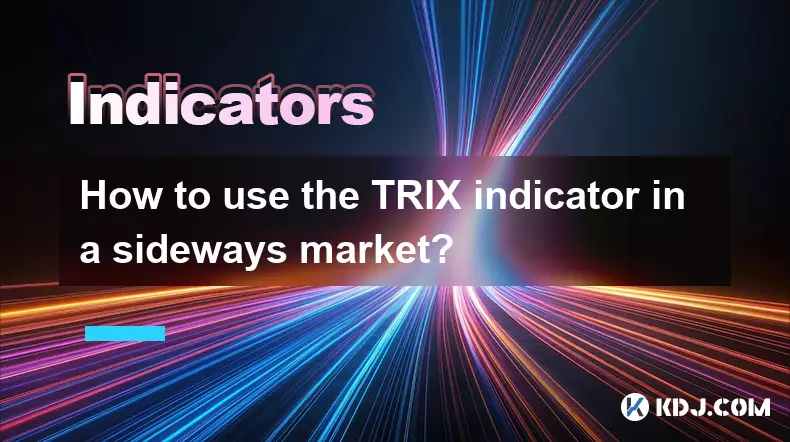
How to use the TRIX indicator in a sideways market?
Nov 10,2025 at 03:00pm
Bitcoin’s Role in Decentralized Finance Evolution1. Bitcoin remains the cornerstone of decentralized finance, serving as both a store of value and a b...
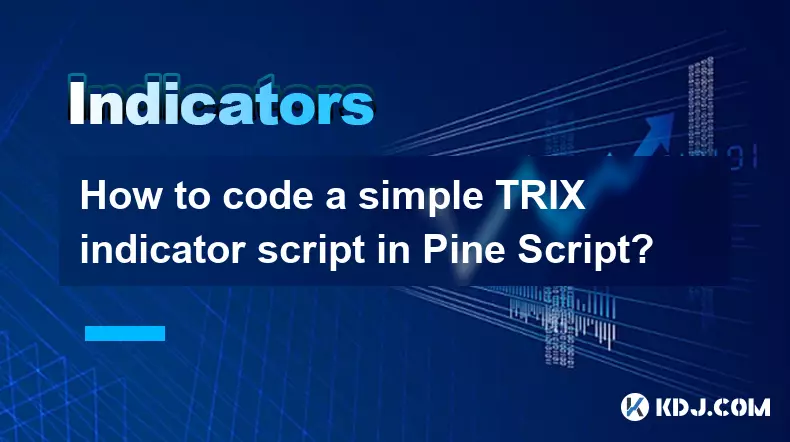
How to code a simple TRIX indicator script in Pine Script?
Nov 07,2025 at 06:20am
How to Code a Simple TRIX Indicator in Pine Script The TRIX (Triple Exponential Moving Average) indicator is widely used in cryptocurrency trading to ...
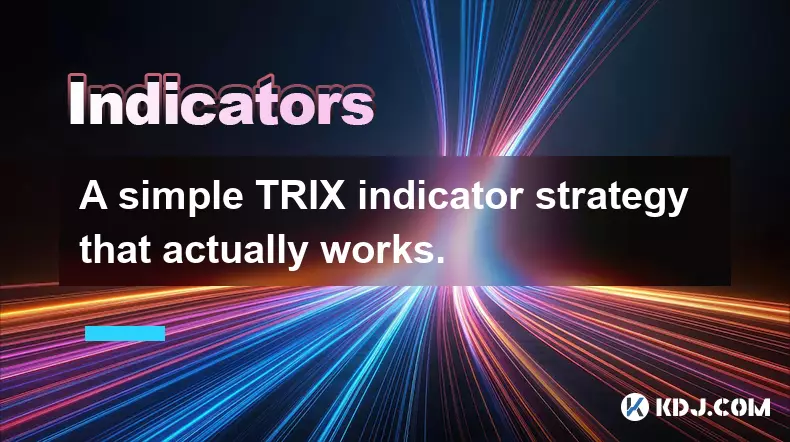
A simple TRIX indicator strategy that actually works.
Nov 08,2025 at 05:39pm
Understanding the TRIX Indicator in Crypto Trading1. The TRIX (Triple Exponential Average) indicator is a momentum oscillator designed to filter out s...

What's the best way to learn the TRIX indicator?
Nov 10,2025 at 12:39pm
Understanding the Basics of the TRIX Indicator1. The TRIX (Triple Exponential Average) indicator is a momentum oscillator designed to filter out short...

How do professional traders use the TRIX indicator?
Nov 06,2025 at 04:40pm
Understanding the TRIX Indicator in Crypto TradingThe TRIX (Triple Exponential Average) indicator is a momentum oscillator used by professional trader...

Can I use the TRIX indicator on my mobile trading app?
Nov 07,2025 at 07:40pm
The TRIX indicator, a momentum oscillator designed to filter out short-term fluctuations and highlight long-term trends, has become increasingly popul...

How to use the TRIX indicator in a sideways market?
Nov 10,2025 at 03:00pm
Bitcoin’s Role in Decentralized Finance Evolution1. Bitcoin remains the cornerstone of decentralized finance, serving as both a store of value and a b...

How to code a simple TRIX indicator script in Pine Script?
Nov 07,2025 at 06:20am
How to Code a Simple TRIX Indicator in Pine Script The TRIX (Triple Exponential Moving Average) indicator is widely used in cryptocurrency trading to ...

A simple TRIX indicator strategy that actually works.
Nov 08,2025 at 05:39pm
Understanding the TRIX Indicator in Crypto Trading1. The TRIX (Triple Exponential Average) indicator is a momentum oscillator designed to filter out s...
See all articles









































































